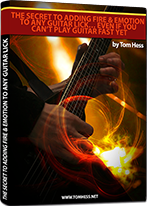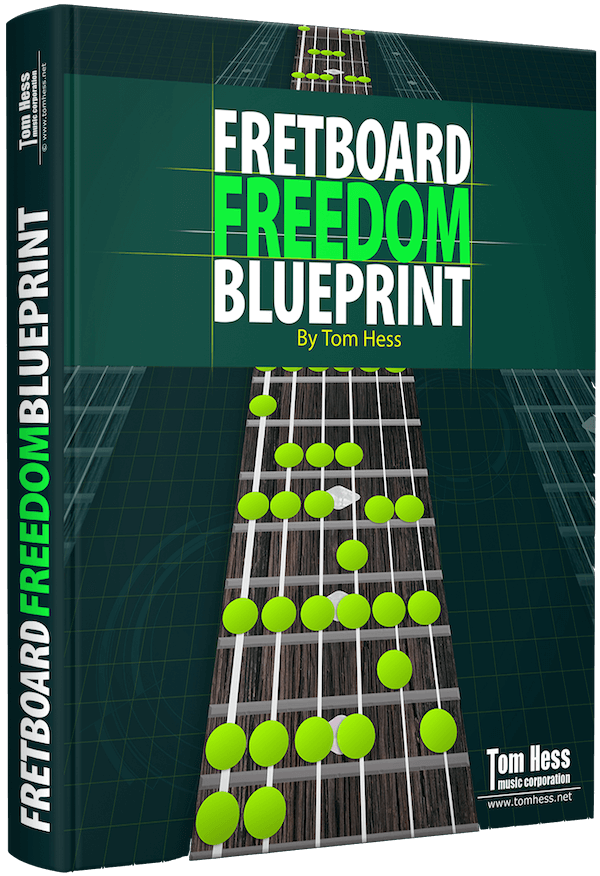The Guide To Playing Guitar Solos Over Chromatic Mediant Chord Changes
Emotion To Any Guitar Lick

EMAIL TO GET ACCESS
By submitting your info, you agree to send it to Tom Hess Music Corporation who will process and use it according to their privacy policy.
If you want to solo with massive emotion and inject your guitar licks and guitar solos with fire and passion you could NEVER get from normal major minor or pentatonic scales…
… you’re in for a treat.
Because I'm about to show you a lead guitar concept I consider the pinnacle of dramatic guitar soloing:
The art of soloing over chromatic mediant chord changes.
What the heck are chromatic mediant chord changes? Why do they sound so dramatic? And why do you rarely hear guitar players talk about them when discussing their guitar solos?
Emotion To Any Guitar Lick

EMAIL TO GET ACCESS
By submitting your info, you agree to send it to Tom Hess Music Corporation who will process and use it according to their privacy policy.
Truth is, most guitarists think that chromatic mediant chord changes are a fairly advanced music theory concept. (This is why few even try to use them.)
But I’ll show you how to make chromatic mediant chord changes very simple (so you can play guitar solos over them starting today, even if you are not an advanced guitar player yet).
I’ll also show you 2 of my favorite guitar scales that are primed for dramatic guitar solos. (So, when you use them – you’ll sound extra awesome when playing guitar licks over chromatic mediant chord changes).
Ready to start?
Watch this video where I show you how to solo with massive emotion:
Now that you know how awesome chromatic mediant chord changes sound, here are the musical skills that help you solo with massive emotion over these chords:
Dramatic Guitar Soloing Tip #1: Become Familiar With The Mixolydian b6 Scale.
The Mixolydian b6th scale (which is simply another name for the 5th mode of melodic minor) is, in my opinion, the ideal scale to use when you want to solo with massive emotion.
It’s almost impossible to play guitar licks or guitar solos from this scale without triggering feelings of longing, sadness or melancholy in your lead guitar playing.
Here is an in-depth tutorial on how this scale sounds and how to create awesome guitar licks from it that you can use to solo with massive emotion:
Question: “But Tom Hess, I heard there are 2 types of melodic minor scale: one type is used when you ascend and the other when you descend! How do you use both types of these scales when you want to solo with massive emotion?”
Answer: Simply use the ONE version of the melodic minor scale that I showed in the video when you play guitar solos. This will help you solo with massive emotion over chromatic mediant chord changes.
That said, make sure you know all 7 shapes of the melodic minor scale COLD. Here is what I mean:
Most guitar players only ever practice one shape of any scale (whichever one they find online) and think they are done learning that scale once they “know” its single shape.
But any guitar scale you learn has multiple shapes. Knowing only one of them makes it very hard to play guitar licks and guitar solos. And it makes it especially hard to know how to solo with massive emotion over chromatic mediant chord changes.
Solution?
Learn to visualize your guitar fretboard as one giant scale shape (where all shapes of the scale fit together as pieces of a jigsaw puzzle). This is what makes it easy to play guitar licks over chromatic mediant chord changes and solo with massive emotion.
Use this free eGuide to help you memorize the shapes of any scale quickly and easily.
Bonus tip: practice memorizing scale shapes away from the guitar. Simply put your fretting hand on your picking hand’s forearm and play through the scale patterns many times during the day. This will reduce the time it takes you to learn the scale patterns and make it much easier to play guitar licks and solo with massive emotion.
Dramatic Guitar Soloing Tip #2: Become Familiar With The Lydian Scale.
If you love the amazing, floating and dreamy sound of guitar players like Steve Vai and Joe Satriani, you’re going to love the Lydian scale.
This is the scale they (and dozens of other guitar players) use to create their signature exotic sound. Similar to the Mixolydian b6 scale, the Lydian scale is a great fit for dramatic guitar soloing over chromatic mediant chord changes.
Here is a video tutorial about the Lydian scale and the awesome guitar licks and dramatic guitar soloing ideas you can create from it:
Question: “Tom Hess, which guitar scale is better when you want to solo with massive emotion? Do guitar licks from the Lydian scale or the Mixolydian b6 scale lend themselves more to dramatic guitar soloing?”
Answer: There is no such thing as “better” when it comes to guitar scales (or playing guitar solos). The Lydian scale is no better or worse than the Mixolydian b6 scale when it comes to playing a guitar solo with massive emotion – they are just different. And both are exceptional choices when you want to solo with massive emotion over chromatic mediant chord changes.
That said, each scale achieves a different type of dramatic guitar soloing feel. This is true whether you solo over diatonic chord changes or chromatic mediant chord changes.
The Lydian scale has a very cool dreamy, floating and slightly exotic feel. And that makes it the ideal choice for guitar licks and guitar solos that require that feeling.
Mixolydian b6 scale is (in my opinion) the most emotional and melancholic guitar scale. So, I use it (instead of the Lydian scale) in guitar licks and guitar solos that require that feel.
Dramatic Guitar Soloing Tip #3: Use Dramatic Vibrato In Your Guitar Licks And Guitar Solos
After you learn the scales to use in your guitar solos over chromatic mediant chord changes…
… the next step to take if you want to solo with massive emotion is to work on your phrasing.
And that starts with working on vibrato.
How do you actually work on vibrato? And how can you make your vibrato better, so you can solo with massive emotion (whether you are trying to do dramatic guitar soloing over chromatic mediant chord changes or any other chord progression)?
Here are the elements of guitar vibrato to focus on:
- Match the depth of your vibrato with its width.
The most expressive vibrato to use when you solo with massive emotion is one that’s both fast and wide (at the same time).
When vibrato is wide but slow, your guitar licks sound like they end on ‘slow bends’ (instead of vibrato).
On the flipside, when your vibrato is fast and narrow – your guitar licks (and guitar solos) sound nervous. And that means, even when you are soloing over chromatic mediant chord changes, your guitar licks and guitar solos won’t sound very expressive.
Watch this video to see what I mean:
- Master delayed vibrato.
Delayed vibrato is one of the telltale signs of dramatic guitar soloing. What is delayed vibrato and how do you use it in your guitar licks and guitar solos?
Simple: you play a note you were ‘going’ to apply vibrato to… and hold it out without vibrato for about 1 second. Then (after a delay of about 1 second) apply vibrato.
The delay may seem subtle, but it goes a LONG way towards helping you solo with massive emotion when you play guitar licks and write guitar solos.
Tip: you can also do delayed vibrato with rearticulation, like this: play the note and hold it out for about 1 second (creating the delay). Then, right before you apply vibrato, pick the note AGAIN (and this time – go to the vibrato directly). This takes the “drama” in your dramatic guitar soloing into overdrive.
See this video to understand what I mean:
- Timing
To make your vibrato sound truly great in your guitar licks and guitar solos, focus on synching up the pulses of your vibrato in time with the beat of the song. Think of pulses of vibrato the same way you’d think about note values of a guitar riff.
Here is a video example of what I mean:
I discovered the above dramatic guitar soloing tips from studying great singers.
And here is an assignment that will help you learn to solo with massive emotion just like I did: transcribe 5-10 vocal melodies of your favorite singers on guitar. Focus on matching their phrasing nuances as best as you can in your guitar licks.
Then use your skills when you play guitar solos over chromatic mediant chord changes and you’ll sound like a pro.
Dramatic Guitar SoloingTip #4: Refine Your Current Skills
This is one of the secrets to being able to solo with massive emotion over chromatic mediant chord changes.
Here is how to do it:
Play these notes on guitar: B string – frets 10, 12 and 13.
Play them once (without worrying about chromatic mediant chord changes) and ask yourself:
How good did these notes sound on a scale of 1-10?
If your answer is not a “10” (i.e. you’re not crying) – ask yourself:
How can you make the rhythm of these 3 notes cooler?
Which note(s) will have vibrato? Will you add vibrato instantly? Or will you delay it, like a singer?
Will you pick ‘all’ 3 notes? Or will you use some hammer ons and pull offs?
How about string bends?
Pre-bends?
Ascending slides?
Descending slides? Pinch harmonics? Vibrato bar dives?
Double stops? Pinch harmonics? Picking hand rakes? Trills?
Do whatever it takes to refine your 3 notes until they sound like a “10”.
You could practice this task for hours.
And as you do, realize:
With this drill, you are training yourself to solo with massive emotion. Because dramatic guitar soloing starts from being able to make the simplest guitar licks sound awesome.
Make this exercise a staple in your dramatic guitar soloing practice. And soon you’ll be able to play guitar licks and guitar solos that impress anyone who hears you play (no matter if you are soloing over chromatic mediant chord changes or not).
Here is a demonstration of this dramatic guitar soloing exercise:
Question: “Tom Hess, when I try to do this dramatic guitar soloing drill I hear a lot of string noise. What can I do?”
Answer: Here are the best ways to control excess string noise:
Use your picking hand’s thumb to rest on the lower (in pitch) strings as you play guitar licks and guitar solos. The thumb should simply slide up and down as you play, keeping your playing clean.
You can also use your fretting hand’s index finger (along with the picking hand’s fingers not holding the pick) to mute the higher (in pitch) strings.
These 3 techniques will help your playing be free of string noise from both directions (very handy when you are playing dramatic guitar solos with aggressive vibrato).
Dramatic Guitar Soloing Tip #5: Combine Speed With Melody In Your Guitar Licks And Guitar Solos
This is quite a bit easier than you might think (even when you are soloing over chromatic mediant chord changes).
Here is how to do it:
Write a vocal melody over a backing track (no matter if the track consists of chromatic mediant chord changes or chords within a single key).
You can write it using your voice or your guitar (if you can resist temptation to play fast) or a piano.
Then, use your melody notes as signposts that will enable you to solo with massive emotion and combine speed with melody.
By “speed”, I mean: fast scale sequences, 2-hand tapping, legato runs, and even arpeggios.
Here is an example of how this sounds:
Question: “But Tom Hess, if I do this as I try to solo with massive emotion, I’ll change the rhythm of my original melody. Is this a problem?”
Answer: No. For 2 reasons: nothing in music is ever a “problem” if you like the end result :) And second: the melody you created was never to be the final solo anyway. It was simply the skeleton for you to practice dramatic guitar soloing techniques.
You can then use the final guitar licks you create to create guitar solos over chromatic mediant chord changes.
Now that you know how to solo with massive emotion, the next step is to learn your guitar fretboard inside and out, so you never get lost when you are improvising guitar licks and playing guitar solos. I can show you how, for free, in my new eGuide called Fretboard Freedom Blueprint. Download it today and discover a nearly effortless way to visualize scales all over your guitar, so you can solo like a pro and impress everyone who hears you play.


Is your guitar playing stuck in a rut? Transform it with the most proven online lessons for rock guitar.
